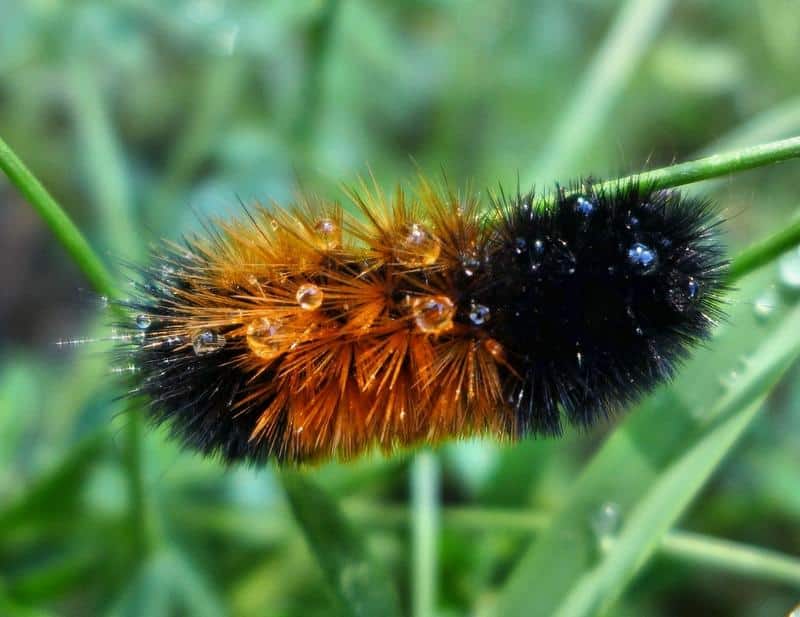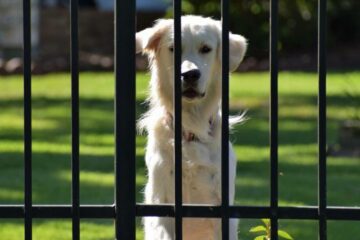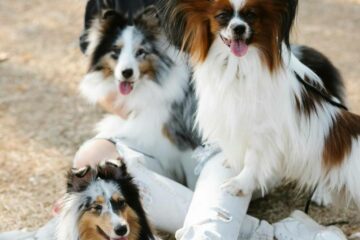Are Woolly Bear Caterpillars Poisonous to Dogs?
Are woolly bear caterpillars poisonous to dogs? In this article, we’ll tell you everything you need to know to keep your dog safe around these black fuzzy caterpillars. After covering if they’re poisonous, we’ll tell you what to do if your dog ate a woolly bear caterpillar, and the command to make sure it never happens again.
Next, we’ll explain exactly what a woolly bear caterpillar looks like so you’ll be sure of what you’re dealing with before going over if woolly caterpillars bite dogs. Finally, we’ll wrap things up by instructing you on how to get rid of woolly bear caterpillars so you can put this all behind you for good. Keep reading!
Woolly Bear Caterpillar Poisonous to Dogs

Woolly bear caterpillars (also known as black fuzzy caterpillars) are not poisonous to dogs. However, their hairs can be irritating and cause mild gastrointestinal upset if ingested. It’s always best to prevent your dog from eating these caterpillars. If your dog ate a woolly bear caterpillar, monitor them closely for any signs of distress and contact your vet if necessary.
Are Black Fuzzy Caterpillars Poisonous to Dogs?
Despite their imposing appearance, woolly bear caterpillars (the black fuzzy caterpillars) are not typically dangerous to dogs. They don’t carry any venom or poisonous toxins. However, the bristly hairs covering their bodies can cause irritation to a dog’s mouth or gastrointestinal tract if ingested.
Symptoms such as drooling, pawing at the mouth, vomiting, or a decreased appetite could indicate that your dog has eaten one of these caterpillars and is experiencing discomfort.
What to Do if My Dog Ate a Woolly Caterpillar
If your dog ate a woolly bear caterpillar, the first step is to remain calm. While these caterpillars aren’t toxic, they can cause discomfort due to their bristly hairs. Monitor your dog for any signs of discomfort, including excessive drooling, pawing at the mouth, vomiting, or loss of appetite.
Provide your dog with plenty of fresh water to help flush out any irritants. If symptoms persist or if your dog seems severely affected, seek veterinary attention immediately.
How to Train the “Leave It” Command
Training your dog to understand and respond to the “Leave It” command can be invaluable in preventing them from eating or interacting with potentially harmful things such as woolly bear caterpillars. Here’s a simple way to train this command:
- Show the treat: Hold a treat in both hands. Show your dog one of the treats and say “Leave It.”
- Wait for their response: Close your hand and wait for your dog to stop trying to get the treat.
- Reward their patience: Once your dog stops, praise them and give them the other treat from your other hand.
- Repeat the training: Repeat this exercise frequently, gradually increasing the challenge by placing the treat on the ground or further away.
These steps will get your dog to stop eating woolly bear caterpillars, but it’s important to remember that the underlying behavioral issues (prey drive, curiosity, etc.) that were causing all of this to begin with will still be present. And until you address those, any positive changes you see are only going to be temporary.
“Well, how do I make these changes last?”
By getting your dog to truly choose to follow your direction, that’s how. I tried many times to write out how you can do that before deciding it made more sense to just link you to the free video series that explains it better than I’d ever be able to.
The series is by a man named Dan who is one of the world’s leading dog obedience trainers. In it, he teaches you how to put an end to things like when your dog eats woolly bear caterpillars and all other misbehavior using his fast and easy-to-follow methods.
In the first video, Dan will reveal to you why the two most common methods of dog training only doom you to failure. You can watch the video now by clicking here. Follow the proven system he’ll show you in his series and you’ll never have to spend another second worrying about your dog eating woolly bear caterpillars ever again!
My Dog Ate a Woolly Bear Caterpillar

If your dog ate a woolly bear caterpillar, there’s generally no cause for alarm as these caterpillars are not toxic to dogs. However, monitor your dog closely for any signs of discomfort or unusual behavior as the caterpillar’s bristles may irritate your dog’s mouth and gastrointestinal tract.
- Observation: Keep an eye on your dog for the next few hours. Look for signs of distress, such as drooling, pawing at the mouth, loss of appetite, vomiting, or diarrhea. If you observe any of these, it’s best to contact your vet immediately.
- Veterinary Consultation: While woolly bear caterpillars aren’t toxic, it’s always a good idea to call your vet and report the incident. They can provide advice based on your dog’s size, breed, and overall health condition.
- Mouth Irritation: Woolly bear caterpillars have a defense mechanism that involves the release of irritating bristles when they feel threatened. If your dog ate one, these bristles could cause discomfort or mild irritation in your dog’s mouth or gastrointestinal tract.
- Behavioral Prevention: Train your dog to not eat or chew on insects or other non-food items. This can be accomplished with positive reinforcement training and by providing plenty of engaging toys for your dog to chew on. Learn the commands you’ll need by going back to the first section.
In conclusion, while woolly bear caterpillars are not toxic, they may still cause mild irritation or discomfort. It’s important for you to monitor your dog closely and consult your vet if necessary. Additionally, training your dog to avoid non-food items can prevent similar incidents in the future (learn how in the first section).
You should definitely handle this problem now so that your dog will also behave during other future insect meetings. That means you won’t have to worry about things like are monarch butterflies poisonous to dogs, what to do when you have a dog bitten by fire ants, do dogs eat cockroaches, or if you should stress if your dog ate ants.
What Does a Woolly Bear Caterpillar Look Like?

The woolly bear caterpillar, scientifically known as Pyrrharctia isabella, is often recognized by its distinctive fuzzy appearance. They typically have a bristly, wool-like coat of long hairs known as setae, colored in a striking pattern of black and brown or reddish-orange bands.
Size and Shape of a Woolly Bear Caterpillar
Woolly bear caterpillars are generally about 1.5 to 2 inches in length. They have a cylindrical body shape that tapers at both ends, similar to most caterpillars. They are covered in bristles that make them look bigger and fluffier than they actually are.
Color and Pattern of a Woolly Bear Caterpillar
The most distinct feature of a woolly bear caterpillar is its color and pattern. They have a banded pattern with black at both ends and a band of brown or reddish-orange in the middle. This unique coloration can vary with some having broader bands of color than others.
Behavior of a Woolly Bear Caterpillar
Woolly bear caterpillars are often found in colder regions and are known for their hardiness. They have a unique behavior of freezing solid in winter, then thawing out and resuming their activities in the spring. In addition, these caterpillars are known for their ‘curl-up’ defense mechanism where they roll their body into a tight coil when threatened.
Environment of a Woolly Bear Caterpillar
Woolly bear caterpillars are quite versatile and can be found in a wide range of habitats, including forests, fields, and gardens. They are most commonly found in colder regions of the United States and Canada, but their range extends to parts of Mexico as well.
The woolly bear caterpillar is identifiable by its unique banding pattern, fuzzy appearance, and its distinctive behavior. Being able to identify this caterpillar can help keep your dog safe in an environment where they might be present. Learn the commands you’ll need to keep your dog safe by going back to the first section.
Do Woolly Bear Caterpillars Bite Dogs?

Woolly bear caterpillars do not bite dogs. They are primarily herbivores and their bristles are a defensive mechanism, not used for biting or stinging. However, if a dog comes into contact with a woolly bear caterpillar, the bristles might cause mild irritation.
- Understanding Woolly Bear Caterpillars: Woolly bear caterpillars are known for their distinctive black and brown banded pattern and a thick, bristly covering. They are herbivorous and do not have the ability or need to bite dogs or any other animals. They eat a variety of plants and leaves.
- Bristles, Not Bites: Although woolly bear caterpillars can’t bite, their bristles can cause mild irritation if touched or ingested. This is a defense mechanism designed to deter predators.
- Signs of Irritation in Dogs: If your dog has come into contact with a woolly bear caterpillar, you might notice signs of discomfort. These can include scratching, rubbing, or pawing at the affected area, excessive drooling, or even mild gastrointestinal distress if the caterpillar was eaten.
- Prevention and Action: To prevent any potential discomfort, it’s best to discourage your dog from investigating or eating caterpillars. If you notice signs of discomfort in your dog, contact your vet for advice. In most cases, the irritation will subside on its own, but it’s always better to be safe and check with a professional.
In conclusion, woolly bear caterpillars do not bite dogs. However, their bristles can cause irritation. It’s always important to monitor your pet and call your vet if you see any signs of discomfort or distress. Learn to keep your dog away from caterpillars by going back to the first section.
How to Get Rid of Woolly Bear Caterpillars
Getting rid of woolly bear caterpillars involves several steps including manual removal, using natural repellents, and creating a garden environment that attracts their natural predators. Although they’re harmless to humans and pets, they can be an occasional garden nuisance due to their leaf-eating habits.
- Manual Removal: One of the most straightforward ways to control a woolly bear caterpillar population is by manual removal. You can easily pick them up (using gloves to avoid any possible irritation from their bristles) and move them to a different location away from your garden.
- Use of Natural Repellents: Certain natural repellents can discourage woolly bear caterpillars. For instance, planting species that caterpillars find unappealing, such as mint, can deter them. Some gardeners also have success using a homemade repellent spray made of water and mild dish soap.
- Attracting Natural Predators: Birds and certain insects are natural predators of the woolly bear caterpillar. Attract these predators to your garden by providing bird feeders and creating habitats for insects like ladybugs and praying mantis, which are known caterpillar predators.
- Proper Garden Maintenance: Regular garden maintenance can go a long way toward preventing an infestation. Remove dead leaves and other garden debris where woolly bear caterpillars might lay their eggs. Regular inspection of your plants can help you spot and address an infestation early.
While woolly bear caterpillars are harmless, they can sometimes become a nuisance in your garden. A combination of manual removal, natural repellents, attracting natural predators, and good garden maintenance can help keep their population under control. To keep your dog away from caterpillars, go back to the first section now.
I’m sure you’re ready to not worry about your dog and these black fuzzy caterpillars anymore, so I’ll let you get started on things. Good luck with all of this, and thanks for reading our article “Are Woolly Bear Caterpillars Poisonous to Dogs?”





